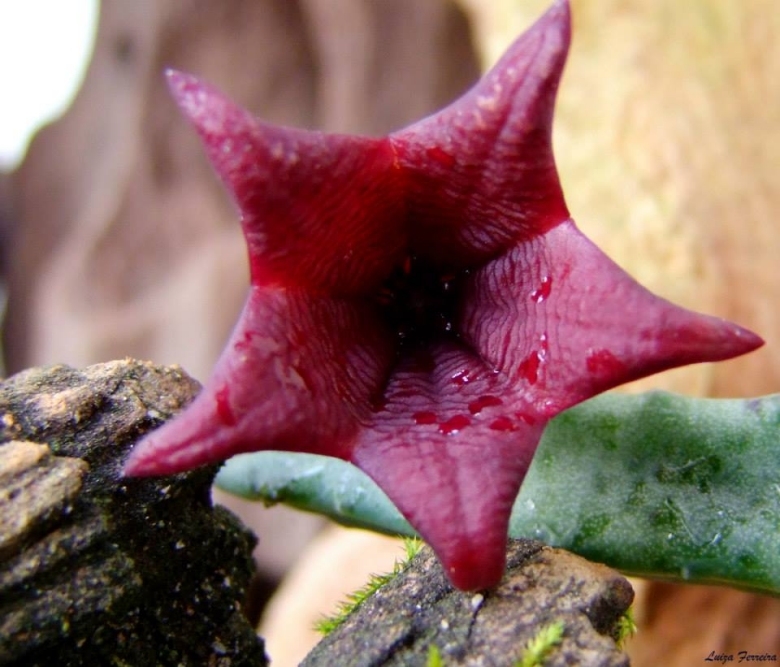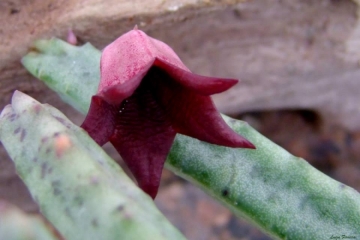




Your support is critical to our success.
S. African J. Bot. 61(4): 206, f. 23, 28 1995
Family: ASCLEPIADACEAE

Origin and Habitat: Namaqualand and Western Karoo to Eastern cape, SouthAfrica (Confined to tributaries of the Gamtoos, Kouga and Baviaanskloof Rivers and Grootrivier where they flow through the Cape Fold Belt mountains (from east of Willowmore to just west of Hankey).
Altitude range: (250-)400-600(- 900) metres above sea level.
Habitat and ecology: Tromotriche baylissiiSN|30717]]SN|30717]] is a curious succulent that is a cliff dweller with stems that hang down from southern and eastern aspects of ledges on shear quartzitic sandstone cliffs. Such plants are known as cremnophytes. Stems lengthen and will root where they find new ledges or crevices, forming new colonies. This active vegetative growth and establishment of new colonies represent an efficient backup ensuring survival in this dry, hostile environment. Associated cremnophytes in the same area comprises: Adromischus cristatusSN|134]]SN|134]] var. zeyheri, Albuca cremnophila, Cotyledon tomentosaSN|27065]]SN|27065]], Cyrtanthus labiatus, Cyrtanthus montanus, Delosperma elsieae, Gasteria rawlinsonii, Haworthia gracilisSN|21283]]SN|15017]] var. picturata, Haworthia viscosaSN|15017]]SN|21283]], Othonna lobataSN|35344]]SN|35344]] and Plectranthus verticillatus. Temperature in summer hot, cooler in winter with the occasional cold fronts. Rainfall (cyclonic winter rainfall and summer thunder showers) is in summer and winter and range from 200–300 mm per annum. This species, is not threatened owing to the sheer cliff-face habitat.
Synonyms:
- Tromotriche baylissii (L.C.Leach) Bruyns
- Tridentea baylissii (L.C.Leach) L.C.Leach
Description: Tromotriche baylissii is a long-lived perennials, succulent with long rope-like stems, pendulous to creeping from rock faces, often filling crevices and some stems becoming subterraneous and rooting. Flowers purplish-red.
Derivation of specific name: After Mr Roy Bayliss (1909–1994), succulent plant enthusiast and the first collector of this species.
Stems: Usually 15 to 150 cm long (occasionally up to 3 metres long) , 6-12 mm in diameter, subterete, dark bluish green, sparsely branched from base, bluntly 4-angled (square in section), sulcate along sides, tessellate, tubercle-toothed, rooting where touching the ground. Older branches becoming smooth and rounded; arboreal stems hanging from ledges. These subterete, rope-like stems are a response to the very xeric and exposed cliff environment. Sap clear.
Leaves; Rudimentary, inconspicuous.
Inflorescence; Shortly pedunculate produced repeatedly along the sides near the tip of the shoots. Flowers opening successively; pedicels short, less than 13 mm long.
Flowers: 5-angled, tubular-campanulate pendulous, spreading, dark purplish-red, with scent of decaying meat, thus attracting pollinators. Corolla up to 15 mm long, 13 mm wide, red-purple on inside; surface satin-like. Tube entirely or irregularly and concentrically marked with maroon, with long vibratile clavate cilia in mouth of tube and sometimes onto lobe margins too.
Blooming season: Spring to midsummer Summer (In habitat January to August).
Fruit; Paired fusiform follicles up to 60 mm long.
Seeds; Flattened and released from the follicles and then dispersed by wind.
Related species: T. baylissii is distinguished from related level-ground Tromotriche species by its long stems, pendulous nature and pendulous spreading campanulate flowers. The other species are cluster-forming and well camouflaged. Its closest relative is Tromotriche choanantha , another cremnophyte very similar in vegetative features, but with a slightly longer corolla and with flowers produced at the base of the long stems.
Bibliography: Major references and further lectures
1) S. African J. Bot. 61: 180-208 1995
2) List South. African Succ. Pl. : 31 1997
3) “Southern African Wild Flowers: Jewels of the Veld” Struik, 2004
4) Peter Goldblatt “Cape Plants: A Conspectus of the Cape Flora of South Africa” National Botanical Institute of South Africa, 2000
5) Victor, J.E. 2005. Tromotriche baylissii (L.C.Leach) Bruyns. National Assessment: Red List of South African Plants version 2014.1. Accessed on 2015/03/07
6) Bruyns P.V. “Stapeliads of Southern Africa and Madagascar- vol. 2; Enumeration of the 220 obligate or near-obligate cremnophilous succulent and bulbous taxa” pages 457-459 University of Pretoria. Umdaus Press, Hatfield. 2005

Tromotriche baylissii Photo by: Luiza Ferreira
The gallery now contains thousands of pictures, however it is possible to do even more. We are, of course, seeking photos of species not yet shown in the gallery but not only that, we are also looking for better pictures than those already present. Read More...
Cultivation and Propagation: Tromotriche baylissiiSN|30717]]SN|30717]] is easy to grow, it needs light shade for best results (but tolerate full sun and shadow), very resistant to heat will also tolerate quite cold temperatures but avoid frost, best in a ventilated environment. It is used mainly as a pot plant or occasionally grown out-of-doors in rockeries. It is ideal for steep embankments, hanging baskets or rockeries.
Spring: When winter ends and they begin to grow again, they will require much water and soaking the pots will no longer put the plants at risk for rot. In the spring they will grow well in partial shade and leaving them out in the rain may provide them with the water they need.
Summer: In the summer months they will tolerate heavy rain, but will be just as happy if the season is dry. It's best to sort out the stems while the plants are resting in the summer before they begin their autumnal growth cycle. They will tolerate very hot weather outdoors as long as they are kept in filtered light and this will encourage them to flower in the Autumn. They also enjoy some fertiliser. Moving the plants as they are developing buds may cause them to spontaneously abort the flowers all together.
Autumn: In the fall keep them outdoors until the night time temperatures drop below the 5°C.
Winter: Winter care presents no problems at 5°-10° C with plenty of light. As soon as they are flowered be sure to take extra precautions to keep them dry, because damp cool conditions when the plants are resting is an invitation to fungal infections, but - according to temperatures –some occasional lit watering may be useful.
Potting medium: Since roots are quite shallow, use a cactus mix or add extra perlite or pumice to regular soil potting soil. A gritty, very free-draining compost is suitable, and clay pots help the plants to dry out between watering. When grown as a pot plant re-pot annually or every other years in fresh soil at the end of the resting season (early spring)..
Pest and diseases: Tromotriche are generally fairly easy to grow, especially if kept pest-free. They are very susceptible to stem and root mealy bugs, and damage from these may well initiate fungal attack. Any time when there is a dead or dying stem in the pot it is important to remove it immediately and completely before other healthy stems can become ill too, isolate the healthy parts, dry them off, and re-root them in new compost. It is quite resistant to the “Balck spot” disease of Asclepiads.
Propagation: Easiest with stem cuttings. Allow cuttings to dry a day before planting. Stems must be laid (Not buried) on gritty compost and will then root from the underside of the stems. It can also be increased from seeds sowing in spring in moist, sandy peat moss. Barely cover seeds. Seeds germinate quickly.
In any season it's best to lay the stems out for several days before replanting them and then pot them only in dry soil and withhold any water until they begin to shrivel or start growing again.
| Your Actions | |
|---|---|
| Back to Tromotriche index | |
| Back to Asclepiadaceae index | |
 |
Back to Succulents Encyclopedia index |
Privacy stantement - Terms and conditions - How to cite - About us - Feedback - Donate



